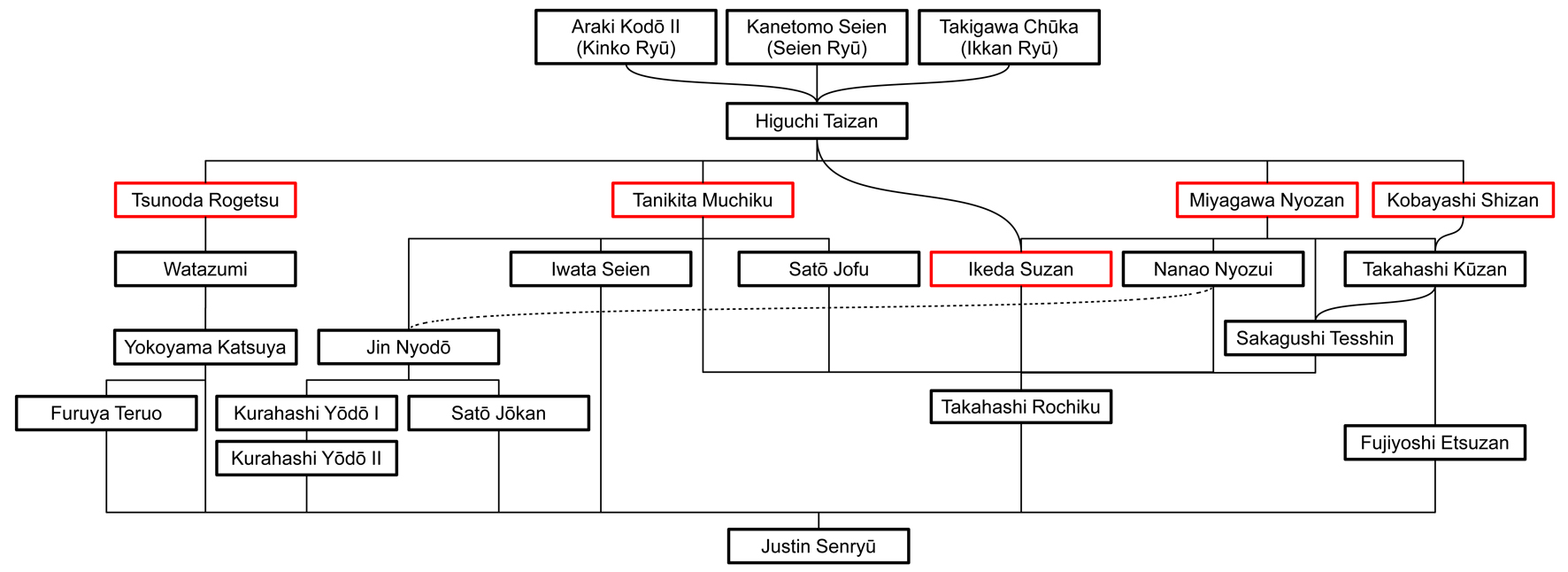Taizan Ryu
Taizan Ryu is an important honkyoku style held in high regard. The school was created in Kyoto by Higuchi Taizan during the Meiji period. Although associated with Kyoto, this style does not actually represent the Edo period style of Kyoto. The original Kyoto honkyoku were transmitted through the Myoan Shimpo Ryu.
Higuchi Taizan
Higuchi Taizan was from Nagoya, a city in between Tokyo and Kyoto, and started his shakuhachi career under Kanetomo Seien, the founder of Seien Ryu. He later studied Kinko Ryu under its Grandmaster, Araki Chikuo, and Ikkan Ryu (effectively a branch of Kinko Ryu) under Takigawa Chuka. He incorporated Seien Ryu and Kinko Ryu honkyoku learned from these teachers into his repertoire which formed its basis. He also added several other pieces to his repertoire, though exactly whom he studied them from remains unclear.
When Taizan moved from Nagoya to Kyoto he started his own school, and eventually instigated the revival of the Myoan temple, Myoanji. This was the Fuke temple which had served as the Kansai region’s head Fuke temple until its destruction in the Buddhist persecution during first years of the Meiji period. The revival movement found a suitable temple for their new location and adopting the name Myoanji from the original temple. Although this was not a revival of the Fuke sect (which had been entirely abolished by the Meiji government), this new temple served as a base for honkyoku activities in the Kyoto area.
Myoan
Although the Myoan temple had a honkyoku tradition (Myoan Shimpo Ryu) which continued after the temple’s destruction, Taizan rather confusingly adopted the name Myoan Ryu as one of the names for his own school, even though his school in fact contained none of the honkyoku from the original Myoan repertoire. To differentiate the two schools, the original Myoan schools are known as Kyu Myoan, meaning ‘ancient Myoan’, or by the name of the main branch, Myoan Shimpo Ryu. For Taizan’s school, since Taizan himself was known to refer to his school also as ‘Taizan Ryu’, this serves as the least confusing and most easily understood name.
Transmission
Among Taizan’s most notable students were Kobayashi Shizan, Miyagawa Nyozan, Tanikita Muchiku and Tsunoda Rogetsu. Justin has received honkyoku of these lineages through a number of teachers.
Jin Nyodo
Justin first studied Taizan Ryu pieces from Kurahashi Yodo II in Kyoto. Kurahashi received these from Jin Nyodo‘s lineage, which contains some of the Taizan Ryu repertoire. Jin’s style is somewhat different from mainstream Taizan Ryu but maintains many of the characteristics, combined with Jin’s austere style and some differences in arrangement. Justin later studied this style from Jin’s top student, Sato Jokan in Kyushu.
Chikushinkai
Tsunoda Rogetsu took Taizan’s style to Kyushu and became the head of the Kyushu branch. Watazumi brought this in turn to Tokyo, where his student Yokoyama Katsuya included a number of the pieces in the repertoire of his school, Chikushinkai. Justin studied these under Yokoyama and his student Furuya Teruo. These also bare the Taizan Ryu characteristics, combined with Watazumi’s deep understanding of and influence from other honkyoku styles and his extraordinary musical talent, creating a very refined yet confident style.
Fujiyoshi Etsuzan
Justin’s next teacher for this style was Fujiyoshi Etsuzan. This was a turning point for Justin. The other teachers represented excellence in music, teaching the pieces in unique and beautiful forms focusing on the styles of Jin and Watazumi, both of whom were highly distinctive and whose repertoires included some of the Taizan Ryu pieces but many from other styles.
Etsuzan represented a style more strictly adhering to the Taizan Ryu style. In the other schools mentioned above, these pieces are not even attributed to Taizan Ryu, although that is their source (see lineage chart below) – and so the Taizan Ryu style’s characteristics are not emphasised. Etsuzan however, keenly differentiated the styles in his repertoire, and taught Justin strictly the particularities of this style. While his teacher Takahashi Kuzan did have his own gentle style which was unique to some degree, he studied Taizan Ryu thoroughly from Miyagawa Nyozan, and also from Kobayashi Shizan, the second head of the school, and his style for these pieces remained particularly close to that of Miyagawa Nyozan. Miyagawa Nyozan is said to have played the Taizan Ryu repertoire in a somewhat different way than Taizan’s later students, having been taught in Taizan’s ‘middle period’ before he his playing had become influenced by the Kyoto musical style.
Iwata Seien
Iwata Seien learned Seien Ryu from his father and two other Seien Ryu masters since he was young. Later he went to Kyoto and studied Taizan Ryu from Taizan’s student, Tanikita Muchiku who was by then the 3rd head of the school. Iwata is one of the few remaining 3rd generation Taizan Ryu players and highly respected for his expertise in this style. Justin learned some of the rarer pieces unique to Taizan Ryu from Iwata in Nagoya.
Takahashi Rochiku
Takahashi Rochiku studied primarily Taizan Ryu, from a total of five teachers, two of whom were direct students of Higuchi Taizan. While Justin studied primarily Shimpo Ryu and Oshu Kei from Rochiku, he also took the opportunity to study Monbiraki, one of the pieces unique to Taizan Ryu.
Lineage Chart
The following chart shows the lineages through which Justin received Taizan Ryu honkyoku. Direct students of Higuchi Taizan have been highlighted in red.

